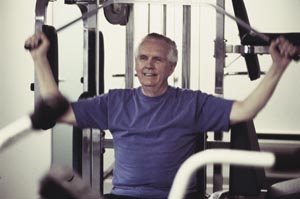New Year’s resolutions that crowd gyms every January suggest people may know the benefits of regular exercise to physical and mental health. Exercise can boost focus and energy as well as improve appearance and even sex life, but sports injuries seen by University of Alabama at Birmingham (UAB) doctors suggest many – particularly men 40 years and older – do not know how to safely maximize the benefits of a new fitness regimen.

Slow and low is the mantra of Marcas Bamman, Ph.D., a professor in the UAB Department of Cell, Developmental and Integrative Biology and the director of the UAB Center for Exercise Medicine.
“If you haven’t been exercising for a while, you need to start slow and develop a fitness base,” said Bamman. “Doing too much too fast is a recipe for injury.”
For patients and study subjects undergoing strength training in the Center for Exercise Medicine, Bamman increases the number of repetitions and the amount of weight over about three weeks under strict supervision. He advises those working out on their own plan on using three-to-six weeks to reach full intensity.
T. Michael Harrington, M.D., agreed. As the chair of UAB’s Department of Family and Community Medicine, he treats plenty of weekend warriors who have overdone it and suffered ligament, tendon, joint or muscle damage.
Tips for getting started:
|
“I tell patients to build up over the course of six weeks, both in the frequency of the workouts and the duration,” Harrington said. “Pushing yourself too hard at the beginning of an exercise regimen increases your risk of injury. Just because you could lift a certain weight or run a certain distance in high school or college doesn’t mean you can do the same thing 20 years later on the first time out. And you don’t want an injury to curtail your ability or enthusiasm for exercising.”
Harrington also recommended that patients ask questions when in doubt. A doctor can make sure they are healthy enough for the kind of workout they intend to do, and a personal trainer can make sure technique is correct and equipment is properly adjusted for the individual.
Setting realistic expectations for results and understanding what the body and mind will experience with a new exercise plan is important. Bamman said most people begin to see positive benefits from exercise within about a month, and many early benefits are psychological: People report they feel more alert and have more energy.
| Strength training is best done twice a week, because the body needs time to recover between sessions. Bamman touts a full-body exercise regimen that includes eight exercises designed to strengthen each of the body’s major muscle groups. He suggests three sets of each, with between eight and 12 repetitions. |
“People engaged in strength training don’t typically see a change in muscle mass over the first six weeks of an exercise program,” Bamman said. “The effect in those first weeks is to help the nervous system better activate existing muscles so they work more efficiently and completely. Actual increases in muscle mass tend to come later.”
Following a slow and low start, a mix of aerobic exercise and strength training is ideal, according to Bamman. He recommends aerobic exercise — activities like running, cycling or swimming — three-to-four days a week, between 20 and 40 minutes per day.
Intensity can also help determine the proper duration of a workout.
“If your exercise intensity is high, the 20-minute timeframe is right for you,” Bamman said. “If your intensity is low or moderate, you’ll need to exercise for the full 40 minutes.”
Heart rate can be used to measure workout intensity. When new to exercise, achieve about 45 to 65 percent of your maximum heart rate. After an exercise baseline is established, get to 60 to 80 percent. A rough rule of thumb for finding maximum heart rate is to subtract one’s age from 220.
Bamman also recommends the talk test.
“If you can carry on a conversation with somebody while exercising, you’re not working hard enough,” he said.
Strength training is best done twice a week, because the body needs time to recover between sessions. Bamman touts a full-body exercise regimen that includes eight exercises designed to strengthen each of the body’s major muscle groups. He suggests three sets of each, with between eight and 12 repetitions.
“This is when you want to push yourself,” Bamman said. “If you do twelve repetitions, make that twelfth one the last one you could possibly manage. If you could do a thirteenth or fourteenth, it’s time to consider adding more weight.”
Once an exercise routine is established, consistency is key to results. Gains made from exercise are quick to fade. Bamman said exercise boosts the production of mitochondria, which he described as the energy generators in the cells. The more generators one has, the more energy he or she has. When a body is sedentary, it does not need as much energy and does not produce mitochondria in large numbers. Start exercising, and mitochondria production soars; stop exercising, and it goes back down.
“If you have a layoff of ten days or so, scale your workout down when you resume and gradually build back up,” said Bamman. “The weekend warrior who only exercises on Saturday never really gets anywhere. By the end of the week, you’ll lose whatever gains you had made and will just be starting over again. You’ll be sore with nothing to show for it.”